Evaluation of Pharmacotherapeutic Management and Factors Associated with Hypertension Control Among Diabetic Hypertensive Patients
Sundas Rehman1, Saba Ijaz2, Asad Khan1*, Hafeez Ur Rehman3, Aamo Khan4 and Abdul Wahid1
1Department of Pharmacy Practice, University of Balochistan, Pakistan
2Federal Government Polyclinic, Pakistan
3Sandeman Provincial Hospital Quetta, Pakistan
4Pakistan Institute of Medical Sciences, Pakistan
Submission:December 22, 2022; Published: January 03, 2023
*Corresponding author: Asad Khan, Faculty of Pharmacy and Health Sciences, Department of Pharmacy Practice, University of Balochistan, Quetta, Pakistan
How to cite this article: Sundas R, Saba I, Asad K, Hafeez Ur R, Aamo K, et al. Evaluation of Pharmacotherapeutic Management and Factors Associated with Hypertension Control Among Diabetic Hypertensive Patients. Palliat Med Care Int J. 2023; 4(2): 555635. DOI: 10.19080/PMCIJ.2023.04.555635
Abstract
Objective: The aim of this study was evaluation of pharmacotherapeutic management and factors associated with hypertension control among diabetic hypertensive patients.
Methods: A prospective observational study design was adopted to conduct descriptive research on hypertensive diabetic patients in outpatient departments of general physician at Bolan Medical Complex Hospital (BMCH) and Sandeman Provincial Hospital (SPH) Quetta, Balochistan. All 365 eligible established diabetic hypertensive patients (having diabetes and hypertension for > 3 months) who are willing to participate by providing written or oral consent were included in the study. Standardized data collection form was used to collect the sociodemographic and clinical data of the patients.
Results: A total of 365 patients were included in the present study. The mean age of study participants was 51.25±13.031 years. Majority of them were females (67.8%), belonging to the age group of 41-60 years (58.1%). About 73.2% of patients had comorbidities. The majority of the patients were on monotherapy (39.2%). However, a notable portion of patients (34%) did not receive any antihypertensive drug. In antihypertensive the most commonly prescribed agents were CCBs (23.8%), followed by RAAs inhibitors (23%), Diuretics (4.9%) and BB (3.3%). univariate analysis, female gender (OR=0.627; p-value=0.037), being married (OR=2.137; p-value=0.045) and smoker (OR=0.649; p-value=0.047) were significantly associated with hypertension control while in multivariate analysis, the only factor which statistical significance with hypertension control the prescription of anti-platelet (OR=2.595; p-value=0.031).
Conclusion: The findings of this study indicated that there was a poor pharmacotherapeutic management among diabetic hypertensive patients where factors like age and drugs selection contributed to compromised blood pressure control in patients with diabetes mellitus.
Keywords: Blood pressure control; Diabetes mellitus; Hypertension; Tertiary care; Guidelines adherence
Introduction
Hypertension is a fatal disease worldwide with 1.39 billion prevalence and 10.4 million deaths per annum [1, 2]. Hypertension control is poor in developing nations with a percentage of 7.7% following the developed nations where it is 28.4% [3]. Hypertension is a global comorbid medical problem among diabetes mellitus patients were as high as 80% diabetic patients are hypertensive [4]. Increased blood pressure is reported in literature, where by 2040 the exceeding rate will be >60% [3,5,6]. Suboptimal hyperglycemic control or unmanaged hyperglycemia probably causes uncontrolled hypertension, resulting in management complication. Multiple studies demonstrate, escalation of micro vascular disease and macro vascular diseases is due to the increase of uncontrolled BP [7]. In Pakistan 35% of hypertensive cases are associated with diabetes mellitus and chronic renal diseases [8]. The management of hypertension is an important determinant to control the high BP. The single entity or combination of antihypertensive both are recommended. The initial regimen: RAS inhibitors and thiazide diuretics prescribed [9].
Calcium Channel Blockers, diuretics and RAS inhibitors can be utilized as initial antihypertensive regimen with/without microalbuminuria in uncontrolled hypertension [10]. However, two or more antihypertensive agents are essential for diabetic hypertension control, individualization of patient is highly recommended [11,12]. Many studies reported poor hypertension control with substandard guideline compliance. Such as, lack of guideline compliance due to “diabetic centric care” practices rather than hypertension management, as well as medication related ADRs and contraindications [13,14]. Another major factor is patients’ unwillingness to opt for the treatment, not considering the predicted diabetic complication [15]. Inadequacy of published literature about hypertension control and management of hypertensive diabetic patients is one of the major causes of suboptimal management of BP. Therefore, the present study was conducted to evaluate the factors and level related to suboptimal BP control and management in outpatients of two tertiary care hospitals in Quetta, Baluchistan.
Methodology
Study design and settings
The current research was a prospective observational study carried out on hypertensive diabetic at outpatient departments of diabetes of Bolan Medical Complex Hospital (BMCH) and Sandeman Provincial Hospital (SPH) Quetta, Balochistan. All eligible established diabetic hypertensive patients (with diabetes and hypertension for > 3 months) who were willing to participate by providing written or oral consent were included in the study. The BP readings were taken after five to seven minutes of patient arrival to the OPD with standard sphygmomanometer.
Study subject
The study participants were diagnosed with hypertensive diabetes following in the age group of 18 to 80 years. Patients suffering from only diabetes or hypertension, diabetic hypertensive patients of age <18 years and >80 years, pregnant diabetic hypertensive patients were excluded. Sample size data was calculated by using Daniel’s calculation formula N=Z2 P (1 P)/d2 [16].
Where,
n = required sample size
Z = Z-statistics for a level of confidence (for 95% level of confidence, Z = 1.96)
P = expected prevalence or proportion of the condition in population based on previous published studies the sample size or pilot studies in proportion of 1, if 20%, p = 0.2.
So, the estimated prevalence of hypertension among diabetic patients=72% 0.72 in the proportion of 1, d = absolute error or precision (in proportion of 1, if 5%, d = 0.05). So, by putting these values in the above-mentioned formula, the sample size ought to be 309 patients. However, with an additional 20% lost to follow rate, a total of 365 patients were enrolled in the current study.
Data collection
Standardized data collection form was used to collect data. The sociodemographic data comprised of patient’s age, gender, residence, smoking and drug addiction statuses. Clinical data included information about blood glucose levels, blood pressure readings, presence and types of comorbidities and medications prescribed to the patients.
Statistical analysis
Data were analyzed through Statistical Package for Social Sciences (SPSS version 23). Percentages and frequencies were used to represent categorical data, furthermore continuous data were presented through ± standard deviation and mean. Univariate binary logistic regression analysis technique was used to identify association between patients’ characteristics (sociodemographic & clinical), antihypertensive therapy, hypertension control and clinical guideline compliance to manage diabetic hypertension. In-order to get the list of factors associated with hypertension control and clinical guideline compliance, all those variables which have p-value less than 0.20 in univariate analysis were checked for collinearity and then it was entered in the MVB LR (multivariate binary logistic regression) analysis. As a result, p-value <0.05 was considered statistically significant.
Ethical approval
Before conducting this study, an ethical approval was acquired from the Research and Ethics committee of University of Baluchistan (Faculty of Pharmacy and Health Sciences).
Results
Patient’s sociodemographic and clinical characteristics
A total of 382 eligible diabetic hypertensive patients were included in the current study. Out of them 365 (94%) participants of study agreed to participate in study. The sociodemographic characteristics of the study participants are given in Table 1. The mean age of study participants was 51.25±13.031 years. Majority of them were females (67.8%), belonged to the age group of 41-60 years (58.1%) were urban residents (53.7%), Pakistani nationals (59.5%), literate (60.5%) and employed (50.4%). Furthermore, the majority diabetic hypertensive patients (73.2%) had an additional comorbidity. Among the comorbidities the most common one was hyperlipidemia (30.4%), followed IHD (27.7%), CKD (8.5%) and cerebrovascular disease (6.6%).
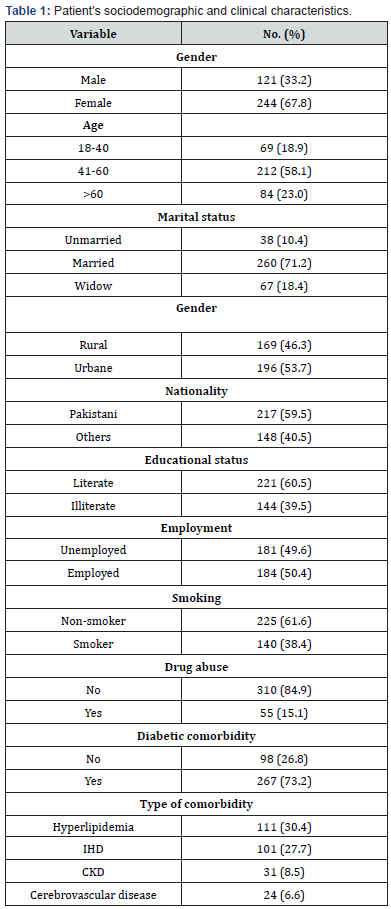
BP and RBG readings on 1st and 2nd visit
Table 2 presents the blood pressure and random glucose readings of study participants. Upon the visit 1, the mean SBP and DBP of patients were respectively, 144.44 ±11.64 mm Hg and 94.41 ±11.883 mm Hg. The majority patients had uncontrolled hypertension (BP > 130/80 mm Hg) (83 %), and their RBG was above normal (RBG > 180 mg/dl) (90.7%). Whereas, on visit 2 the mean SBP and DBP of patients were respectively, 136.52 ± 88.99mm Hg and 88.99 ± 10.024 mm Hg. The majority of patients were at controlled hypertension (57.3 %) and with above normal RBG level (71.5%).
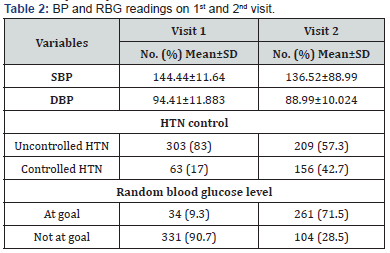
Anti-Hypertensive therapy for management of diabetic hypertension and guideline compliance
Table 3 present the antihypertensive and other drugs prescribed for the management of hypertension and other diseases. The majority of the patients were on monotherapy (39.2%). However, a notable portion of patients (34%) did not receive any antihypertensive drug. In antihypertensive the most commonly prescribed agents were CCBs (23.8%), followed by RAAs inhibitors (23%), Diuretics (4.9%) and BB (3.3%). Large number of patients receiving monotherapy (39.2%), more prescribed antihypertensive were mono anti-HTN therapy (263.8%) and agents other than anti-HTN therapy (statins; antiplatelet) (35.6.6%); and at combination therapy of CCB+ARBs (10.4%). Upon evaluating the 365 prescriptions written to the study participants, a total of 225 (61.6%) prescriptions were judged guidelines compliant.
Factors associated with prescribed guideline compliance
Table 4 present univariate analysis, patie3.4)f age 41-60 years (OR = 0.560; p-value = 0.078), married (OR = 0.185; p-value = 0.001), illiterate (OR = 1.659; p-value = 0.025), employed (OR = 1.637; p-value = 0.023), smokers (OR = 0.523; p-value = 0.003) and drug abusers (OR = 0.397; p-value = 0.008) were considerably associated with guideline compliance (Table 4). However, in MVBLRA, the patients’ age of 41-60 years (OR = 2.830; p-value = 0.002), being drug abuser (OR = 2.465; p-value=0.018) illiterate (OR = 2.058; p-value = 0.011) had statistically substantial positive association with guidelines compliance, whereas, being married (OR = 0.150; p-value = 0.000), and smokers (OR = 0.548; p-value = 0.020) had statistically significant negative association with guidelines compliance.
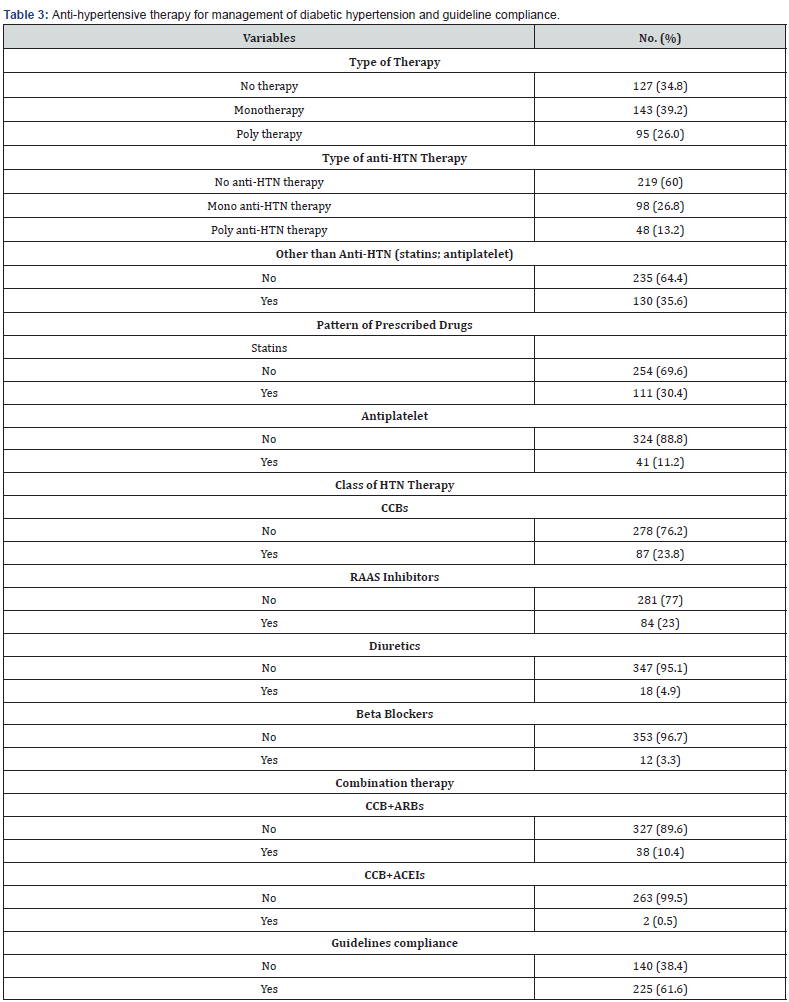
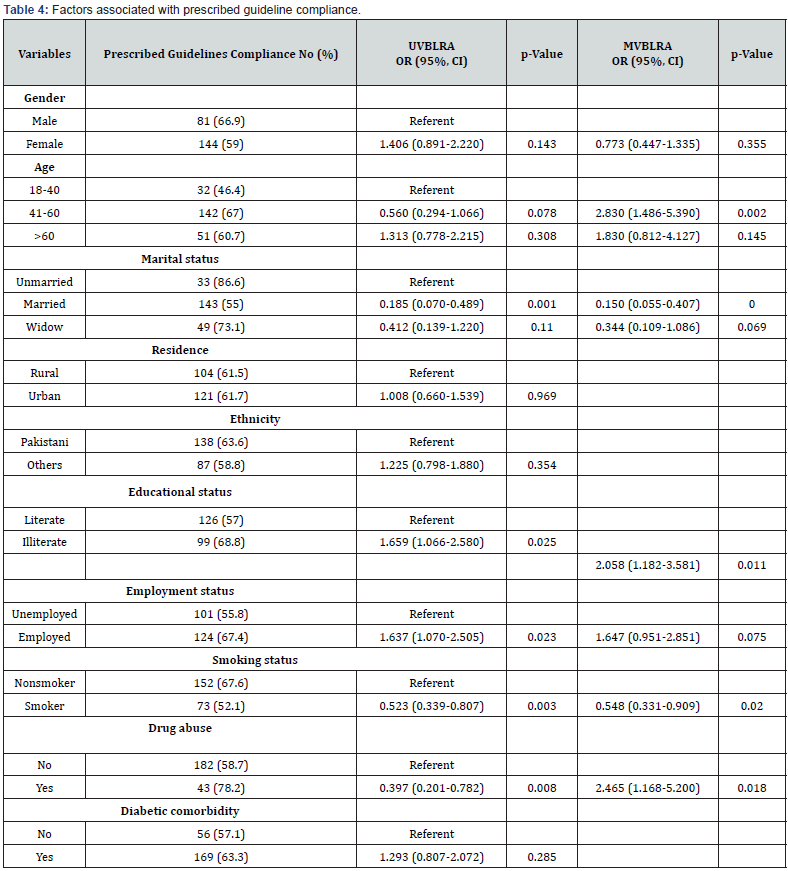
Factors associated with hypertension control
In Table 5 univariate analysis, female gender (OR=0.627; p-value=0.037), being married (OR=2.137; p-value=0.045) and smoker (OR=0.649; p-value=0.047) were significantly associated with hypertension control. However, in MVBLRA, the only factor which has statistical significance with hypertension controls the prescription of anti-platelet (OR=2.595; p-value=0.031). So those patients who received anti-platelets were 2.5 times more likely to be on goal BP than their counterparts.
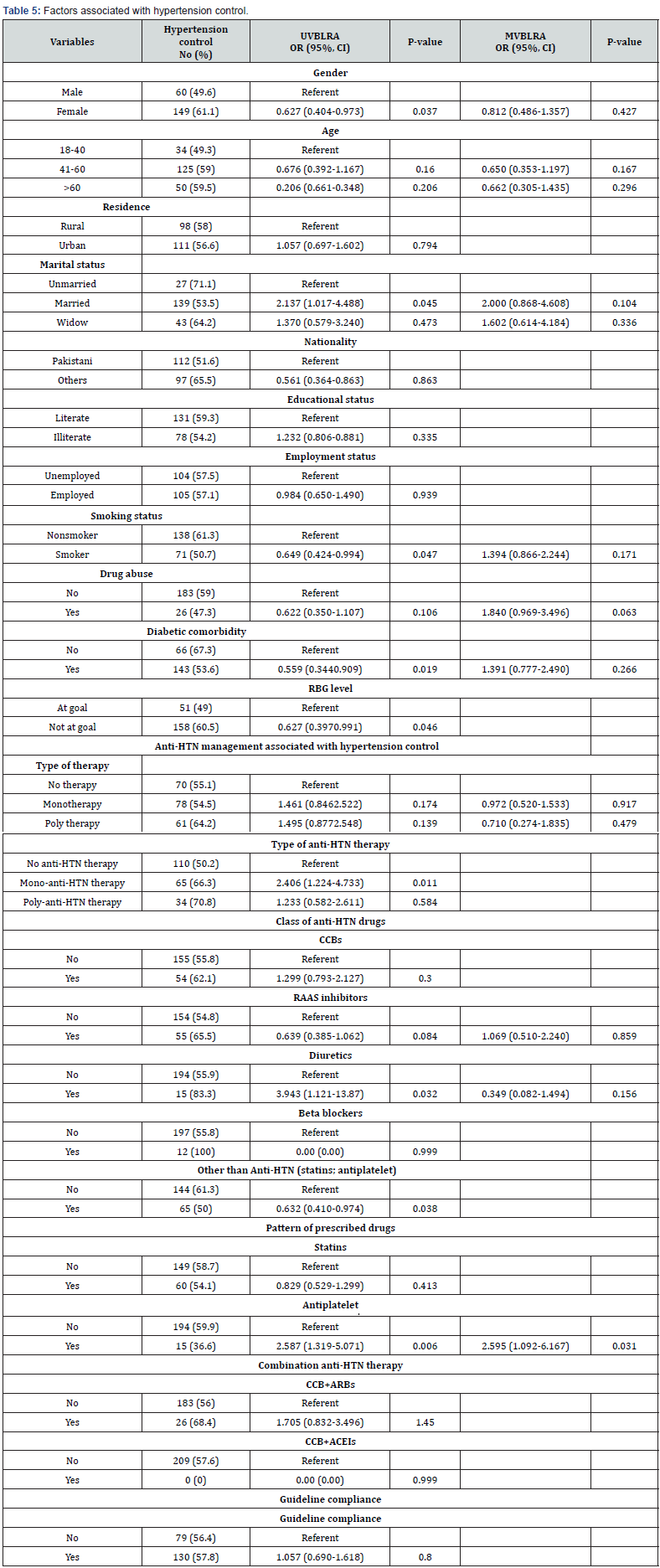
Discussion
Hypertension control
To the best of our knowledge, this is the first study to evaluate factors associated with hypertension control and management at tertiary care hospitals in Baluchistan, Pakistan. The majority of patients were initially reported having high level of uncontrolled hypertension 83% with and without antihypertensive therapy in endocrine diabetic OPD, which is a bit higher proportion comparatively to studies conducted in south Africa (75.5%) [17]. 72.6% in randomized controlled trial in California inconsistent to the results of current study [18] and 43% in Pakistan [19].
Coexistence of hypertension and diabetes are important factors of arterial stiffness and endothelial dysfunction [20,21] On visit one the average systolic BP 144.44 ±11.64 mmHg and diastolic blood pressure is 94 ±11.883 mmHg in present studies, alike, the studies conducted as secondary analysis of two randomized control trial study; according to ACCORD on baseline visit, the standard SBP was 140 mmHg 15% and DBP 10% [22]. Also in another study, SBP was >140mmHg 17.8% and DBP >90 mmHg 10.6% [23]. Upon subsequent visit participants on antihypertensive and other drugs, observed with significant controlled hypertension, in accordance with the reported studies. [24]. The diabetic comorbidities with HTN in current study population is 73.2 %, which is in line with three south Asian countries [25]. Inconsistent with other studies reported 95% prevalence: as well, hypertension a major comorbid condition [26].
Hypertension management in study participants
In current study majority of the patients were on monotherapy (anti-HTN +secondary preventive agents) 39.2%, parallel with >10 years survey study in US with 40.1% [27]. Monotherapy is preferable in diabetic comorbid patients, to enhance patient’s compliance. Remarkably low proportion of patients (34%) were receiving the antihypertensive therapy; in contrast, recent studies reported that in Bahrain 95%, in Chile 91.5% [28]. In our study insufficient prescribed mono-antihypertensive (26.8%), most commonly CCBs (23.8%) are insufficient, in reported study the patients on monotherapy 57% & only 8% on CCBs [29]. In combination therapy CCB+ARB (10.4%) prescribed, consistent with study elsewhere [30,31]. CCBs are clinically effective in adult patients due to low salt and renin level, additionally, RAIs+CCBs clinically beneficial in attaining BP control with CVD risk. Other secondary agents (statins; antiplatelet) (35.6%) to reduce BP. As maximum number of patients were receiving prescriptions according to guidelines.
However, these do not pertain to the targeted antihypertensive regimen still, has positive clinical outcomes, due to the coexistence of other comorbidities and “diabetic centric care” practices of prescribers. Moreover, other pharmacotherapeutic agents were also prescribed to facilitate BP control i.e., statins 30.4% are adequately prescribed. As same percent of patients with hyperlipidemia comorbidity were observed, in line with reported study [32]. Evidently, statins have clinically significant effect in lowering blood pressure [33,34].
Guideline compliance
The current study presents rational findings of prescribers’ clinical guideline compliance (61.6%) with prescription of antihypertensive therapy and secondary preventive therapy, respectively in diabetic hypertensive patients with other comorbidities. Consistent with same findings of conducted cross-sectional study in Malaysia 67.1%, also reported in Cyprus [11,35,36]. In another meta-analysis of 49 trials, including large diabetic hypertensive study participants, the antihypertensive medications had beneficial clinical outcomes with other comorbidities [37]. Whereas the results of study conducted in urban Pakistan were incompatible to our study [38].
Factors associated with HTN control
In current cohort study, females had better blood pressure control unlikely to studies reported elsewhere [39], can be accomplish by healthy diet and improved physical activity, subsequent visit to health care service [40]. BP control in married participants reported previously parallel to findings of this study [41]. Married adults have responsibilities of family in this regard they must maintain BP control. The smoking participants have blood pressure control similar findings supported somewhere else [42,43], studies indicated there is no relationship of dose-effect between BP control and smoking [44]. In multivariate analysis only the patients receiving antiplatelet have statistically fine association with hypertension control. In documented studies, improved blood pressure control validated with antiplatelet in patients with CVD (i.e., IHD) [45,46].
6.5. Factors associated with guidelines compliance
Our findings indicate factors associated with guideline compliance of antihypertensive with prescribing practices among adult illiterate, and drug abusers similar to conducted studies [47-49]. Because it’s difficult for illiterate people to efficiently communicate and understand the non-pharmacological recommendations. Substance abuse has a strong clinical association with sudden elevation of blood pressure. Many abusive substances have potential vasoconstriction properties [49]. Therefore, prescription of antihypertensive is good in the study among illiterate and drug abusers.
Though, the pharmacist’s presence facilitates the rational prescription pattern according to individual need and status of disease. The pharmacological approach is more reasonable in adult patients with comorbidities. Physicians make it mandatory to evaluate the blood pressure of diabetic adults with or without comorbidities, to shield the unforeseen diabetic related issues. The assessment of constraint consultation time, duration and dosage, other metabolic laboratory tests and BMI measurements were the major limitations of our study.
Conclusion
The findings of this study indicated that there was a poor pharmacotherapeutic management among diabetic hypertensive patients where factors like age and drugs selection contributed to compromised blood pressure control in patients with diabetes mellitus.






























